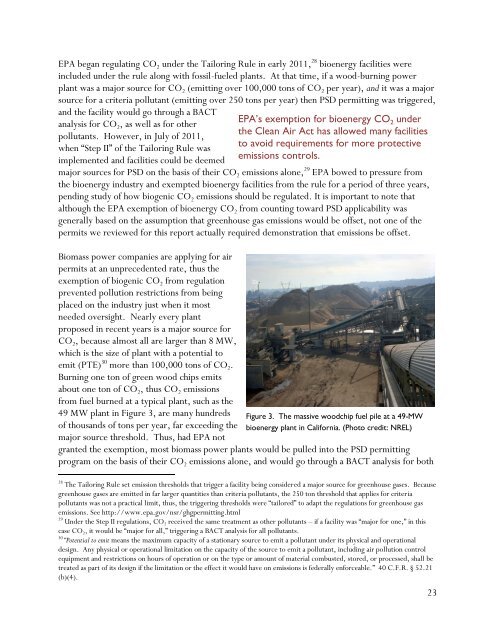PFPI-BiomassIsTheNewCoal-April-2-2014
PFPI-BiomassIsTheNewCoal-April-2-2014
PFPI-BiomassIsTheNewCoal-April-2-2014
- No tags were found...
You also want an ePaper? Increase the reach of your titles
YUMPU automatically turns print PDFs into web optimized ePapers that Google loves.
EPA began regulating CO 2 under the Tailoring Rule in early 2011, 28 bioenergy facilities wereincluded under the rule along with fossil-fueled plants. At that time, if a wood-burning powerplant was a major source for CO 2 (emitting over 100,000 tons of CO 2 per year), and it was a majorsource for a criteria pollutant (emitting over 250 tons per year) then PSD permitting was triggered,and the facility would go through a BACTanalysis for CO 2 , as well as for otherpollutants. However, in July of 2011,when “Step II” of the Tailoring Rule wasimplemented and facilities could be deemedEPA’s exemption for bioenergy CO 2 underthe Clean Air Act has allowed many facilitiesto avoid requirements for more protectiveemissions controls.major sources for PSD on the basis of their CO 2 emissions alone, 29 EPA bowed to pressure fromthe bioenergy industry and exempted bioenergy facilities from the rule for a period of three years,pending study of how biogenic CO 2 emissions should be regulated. It is important to note thatalthough the EPA exemption of bioenergy CO 2 from counting toward PSD applicability wasgenerally based on the assumption that greenhouse gas emissions would be offset, not one of thepermits we reviewed for this report actually required demonstration that emissions be offset.Biomass power companies are applying for airpermits at an unprecedented rate, thus theexemption of biogenic CO 2 from regulationprevented pollution restrictions from beingplaced on the industry just when it mostneeded oversight. Nearly every plantproposed in recent years is a major source forCO 2 , because almost all are larger than 8 MW,which is the size of plant with a potential toemit (PTE) 30 more than 100,000 tons of CO 2 .Burning one ton of green wood chips emitsabout one ton of CO 2 , thus CO 2 emissionsfrom fuel burned at a typical plant, such as the49 MW plant in Figure 3, are many hundreds Figure 3. The massive woodchip fuel pile at a 49-MWof thousands of tons per year, far exceeding the bioenergy plant in California. (Photo credit: NREL)major source threshold. Thus, had EPA notgranted the exemption, most biomass power plants would be pulled into the PSD permittingprogram on the basis of their CO 2 emissions alone, and would go through a BACT analysis for both28The Tailoring Rule set emission thresholds that trigger a facility being considered a major source for greenhouse gases. Becausegreenhouse gases are emitted in far larger quantities than criteria pollutants, the 250 ton threshold that applies for criteriapollutants was not a practical limit, thus, the triggering thresholds were “tailored” to adapt the regulations for greenhouse gasemissions. See http://www.epa.gov/nsr/ghgpermitting.html29Under the Step II regulations, CO 2 received the same treatment as other pollutants – if a facility was “major for one,” in thiscase CO 2 , it would be “major for all,” triggering a BACT analysis for all pollutants.30“Potential to emit means the maximum capacity of a stationary source to emit a pollutant under its physical and operationaldesign. Any physical or operational limitation on the capacity of the source to emit a pollutant, including air pollution controlequipment and restrictions on hours of operation or on the type or amount of material combusted, stored, or processed, shall betreated as part of its design if the limitation or the effect it would have on emissions is federally enforceable.” 40 C.F.R. § 52.21(b)(4).23



